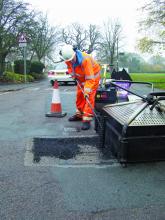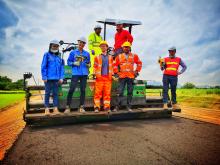Shell’s highly innovative bitumen and asphalt solutions are helping create future-ready urban road networks around the world to meet the needs of today and tomorrow. Shell’s general manager of bitumen technology, Professor John Read, takes a look at some of the company’s game-changing ideas.
The next 30 or so years will see a significant transformation in the way we live. Whereas almost 75% of the world’s population lived in rural locations in 1950, around 75% will live in cities by 2050. The global popu

Professor John Read: bitumen must be adaptable
The next 30 or so years will see a significant transformation in the way we live. Whereas almost 75% of the world’s population lived in rural locations in 1950, around 75% will live in cities by 2050. The global population will have grown by another 2 billion, from today’s 7 billion, to 9 billion. We will be building the equivalent of a new city of more than 1.4 million people every week, with the greatest growth in urban population set to be in China, India, the US and Nigeria. And there will be triple the number of vehicles on roads.
Roads have long been regarded as a barometer of a country or community’s prosperity. The World Bank has said that it is better to invest a dollar in roads than a dollar in irrigation. If you connect two villages, they begin to trade. That creates wealth which is used to purchase goods. Then you create the next village road and trade link.
Of course, the same is true in developed markets. Roads create markets and drive – literally - the connectivity between communities; they are the lifeblood of society. Economic and social costs of managing and developing the road network are enormous. Take the European network. It consists of 5.5 million kilometres and it would cost over €8,000 billion (nearly US$8,500 billion) to reconstruct. As a result, safeguarding and future-proofing our road networks is an urgent imperative for today and tomorrow.
This is especially true today in cities and major conurbations where roads have to be safer, more durable and laid out under much more challenging conditions than ever before. That’s due to a variety of factors: increased urbanisation, impact of climate on pavements, greater volume of traffic and heavier vehicular loads.
Bitumen remains vital
Bitumen is a vital ingredient in road construction and maintenance. Of the total global bitumen market, 70% goes into roads. The rest is used in other vital transport and building infrastructure.Currently, world bitumen demand is between 95 million to 110 million tonnes. The market is growing, reflecting increased road development in India, China and South East Asia, as well as continued road maintenance programmes. By 2020, we expect volumes to rise to around 130 million tonnes and emerging markets will drive this demand. The so-called ‘Stan’ republics in Central Asia are key growth markets that do not have a developed road network but are taking measures to build transport infrastructure. After these countries, we think it will be Africa’s turn: first, the coastal locations exposed to the wider world, followed by countries further inland.
In view of such developments, it is essential that bitumen adapts to changing needs. As the world’s largest bitumen marketing business with over 1,600 customers across 28 countries and a heritage of almost 100 years, it’s a challenge that is at the forefront of our thinking.
While we cannot predict what the precise issues will be in 2030, 2040 or 2050, we can imagine what the world might look like. Shell has been developing possible visions of the future since the 1970s, helping generations of Shell leaders explore ways forward and make better decisions. Shell Scenarios ask “What if?” questions encouraging leaders to consider events that may only be remote possibilities, and stretch their thinking. Our Scenarios also help governments, academia and business in understanding possibilities and uncertainties ahead.
I’ll touch on two of these from Shell Scenarios which could have an impact on the future of roads.
Compact cities
Urbanisation can bring benefits – accelerated innovation, more collaboration and a wider distribution of economic development leading to greater overall prosperity. But if managed poorly, urbanisation could lead to declining quality of life.The shift to urban living will intensify demand for resources including water, food and energy. Yet it will also be vital to preserve productive arable land to feed the world’s growing population. The character and quality of future urbanisation will, therefore, have a huge influence on global resource efficiency and sustainability, directly affecting the quality of life for billions of people.
Despite the differences between cities, best practice does exist around urban development and how to manage it. Compact, densely populated, well-planned cities with effective integrated infrastructure and services are more resource-efficient. With appropriate attention, they can also be attractive places to live.
Trends in road travel
A key feature of more compact cities is a likely decrease in travel kilometres arising from shorter average journeys, as well as a shift to public transport and two-wheeled vehicles. Furthermore, policies for compact cities go hand in hand with measures to impose vehicle fuel economy standards – an imposition made easier because the inhabitants of these cities tend to use smaller or hybrid vehicles or purchase electric vehicles, both battery and hydrogen powered. Tailpipe emission standards, anti-pollution measures, fuel taxes and embedded CO2 footprint taxes on imports also play a role in driving efficiencies.Energy service demands for transport are likely to grow three to four times larger than they are now, even assuming significant energy efficiency improvements and a far greater proportion of the global population living closer together in highly compact cities. At the moment, the global transport sector, with the exception of rail, is almost entirely powered by liquid hydrocarbons, including petrol, diesel and bunker fuel for shipping. The potential to decarbonise varies across different transport subsectors.
Passenger road transport will be the easiest to electrify, with battery and fuel cell electric vehicles potentially reaching 80% of the global passenger car fleet over coming decades. Electric vehicles are particularly suited for short- and medium-distance travel in urban environments and densely populated regions, where recharging points can be easily concentrated to minimise the risk of batteries running out of power mid-journey.
Bitumens of the future
These trends and others are of paramount concern to Shell and its scientists. From our global R&D centre in Bangalore, India, we have scientists working at a molecular level to enhance bitumen with properties that will be needed in the future.Some of these innovations will take a decade or more to come to the market, but others have recently come on-stream. Shell Bitufresh removes smell from bitumen, rather than simply masking it. This is done by chemically converting the mercaptans - the smell-generating compounds within bitumen - by attaching very heavy molecules from the Bitufresh to the mercaptans. This makes them incredibly heavy and dense so that they sink to the bottom of the bitumen, thereby preventing their release which creates the smell. It won the research category of the 2015 Global Road Achievement Awards by the International Road Federation in the research category.
Ten years ago we started to explore the technical feasibility of changing the visual appearance – phosphorescence - of road pavement surfaces in order to provide ambient lighting, alert traffic to changes of road driving condition or even danger. Work is now underway with suppliers of phosphorescent products and universities dedicated to tailoring phosphorescent products in order to investigate the real feasibility of producing phosphorescent asphalt mixes.
Another development that is within reach is a road surface that can take harmful substances like nitrogen dioxide (NO2) or particulate matter out of the air, to be washed away with the rain.
Behind the scenes, we have identified 13 deficiencies common to bitumen. They include poor adhesion, poor cohesion, poor ductility, low viscosity, high viscosity or unpleasant smell. Seven or eight of these deficiencies can now be rectified, thanks to Shell Bitumen molecular engineering. By the end of 2018 or early 2019, we expect to have 10 of the 13 bitumen make-up deficiencies cracked. What we’re looking to do is make all these new bitumen make-up technologies for post-processing residue available at depots, rather than at refineries, in order to maximise competitiveness.
When I think about 2050 and the increase in urbanisation, it makes sense that we use all the assets at our disposal to anticipate the type of energy that people will need. At the Make the Future festival in the UK last July, we showcased our partnership with Pavegen where children in London could understand how children in Rio are powering the lighting for their football pitch through piezoelectricity. In Rio, the six LED floodlights surrounding the pitch are powered by 200 kinetic tiles buried under the AstroTurf and which capture the energy generated by the players' activity, namely the piezo pressure exerted by their feet. As a result, the pitch can be used at night with no cost for lighting.
We are conceptualising how this technology could act as a means to inform local authorities and their contractors that a road is failing. As a road deforms, the piezo would give out a higher electrical current which could then be converted into an indication of damage. It is also possible that piezo could be used to generate electricity to feed the grid. However, as the road surface needs to be much stiffer than an artificial sports pitch, it is arguable that only a small amount of electricity could be generated this way. The future is interesting nevertheless and we will continue to develop conceptual models.
Sustainable roads
While we are planning and investing for the future, we do not have to look too far ahead to recognise that as a society we must recycle more and conserve resources.About 85% of road construction activity is repair and maintenance. As a result, there is an increasing demand to use reclaimed aggregate products (RAP) in road construction.
Although RAP makes huge sense from a sustainability perspective in addressing concerns such as resource use and energy efficiency, questions remain about its quality and consistency in comparison to virgin asphalt. To that end, we have focused a considerable part of our R&D on understanding and developing solutions for RAP to deliver compact and durable solutions. Our new Compact product range, scheduled for European rollout early next year, will deliver improved adhesion and compaction for use with recycled materials on less trafficked roads.
For example, we are trialling Shell Cariphalte RC 45/80-80 in Switzerland. The Shell Cariphalte family has been used for over 40 years across many demanding projects. Shell Cariphalte RC 45/80-80 is characterised by a high elasticity that allows a large percentage of recycling material to be used without compromising on quality. The trial under Swiss standards for asphalt recycling is to evaluate its use in road surfaces where noise reduction is required.
Ultimately, we believe that our innovative approach helps to reduce our impact on the environment, to operate safely and to share the benefits with communities of developing energy resources. We are inspired to think about what roads can do beyond carrying people and goods from A to B. It’s demonstrated in the 49 active patent series that we hold that are linked to bitumen and asphalt, and in our drive to challenge norms.
So when we think about what the future of roads may look like in 10, 20 or 50 years’ time, we can honestly say that we have been asking these questions for as long as we have been in the business of bitumen.









